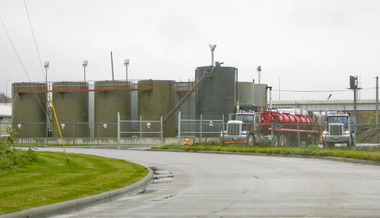http://www.cleveland.com/metro/index.ssf/2013/08/youngstown_man_admits_dumping.html#incart_river_default
Cleveland.com
By James F. McCarty, The Plain Dealer
on August 29, 2013 at 12:30 PM, updated August 29, 2013 at 2:28 PM

Hardrock Excavating is one of several oil and gas drilling-related companies Ben Lupo owns in the Youngstown area. It houses 58 20,000-gallon storage tanks.
Associated Press file photo
CLEVELAND, Ohio — An employee of a Youngstown company that stored, treated and disposed of oil and gas drilling liquids admitted this morning to dumping tens of thousands of gallons of fracking waste on at least 24 occasions into a tributary of the Mahoning River.
Michael Guesman appeared in U.S. District Court where he pleaded guilty to a charge of unpermitted discharge of pollutants under the Clean Water Act. He faces a sentence of about a year in federal prison, although his time could be reduced by the amount of assistance he provides to prosecutors, and his acceptance of responsibility for his crime.
Guesman 34, of Cortland, said he acted on the orders of his boss at Hardrock Excavating, owner Benedict Lupo, when ran a hose from the 20,000-gallon storage tanks to a nearby storm water drain and opened the release valve. A gusher of waste liquid left over from hydraulic fracturing operations — commonly known as “fracking” — poured into the drain, sending saltwater brine and a slurry of toxic oil-based drilling mud, containing benzene, toluene and other hazardous pollutants, flowing into the Mahoning, prosecutors said.
Assistant U.S. Attorney Brad Beeson said Guesman is cooperating with investigators, and if necessary will testify for the government at the trial of Lupo, which has not yet been scheduled.
Guesman has told investigators that, between Nov. 1 and Jan. 31, Lupo instructed him to dump the fracking waste into the storm sewer at least 24 times, always after dark and after all of the other employees had left the facility, Beeson said.
The black fracking waste left a smelly, oily sheen on the Mahoning, which was located less than a mile away from the Hardrock facility and its 58 storage tanks, investigators said.
U.S. District Judge Donald Nugent scheduled sentencing for Nov. 15.
Lupo, 62, of Poland, Ohio, has pleaded not guilty to charges of violating the federal Clean Water Act.
An anonymous tipster alerted authorities from the Ohio Department of Natural Resources that the improper dumping of fracking waste was occurring, and state agents observed the crime as it was being committed, according to court documents.
Guesman told the agents that Lupo ordered him to lie if questioned about the dumping, and to tell law enforcement officers he had emptied the waste tanks only six times, when in fact he had done it at least four times that number, documents state.
The fracking process involves injecting millions of gallons of chemical-laced water to crack open rock formations holding gas deposits deep under the Earth’s surface. Ohio allows for disposing of fracking waste in state-permitted injection wells.
Special thanks to Richard Charter
